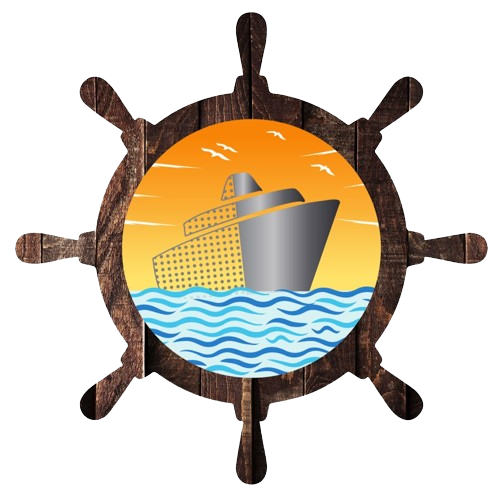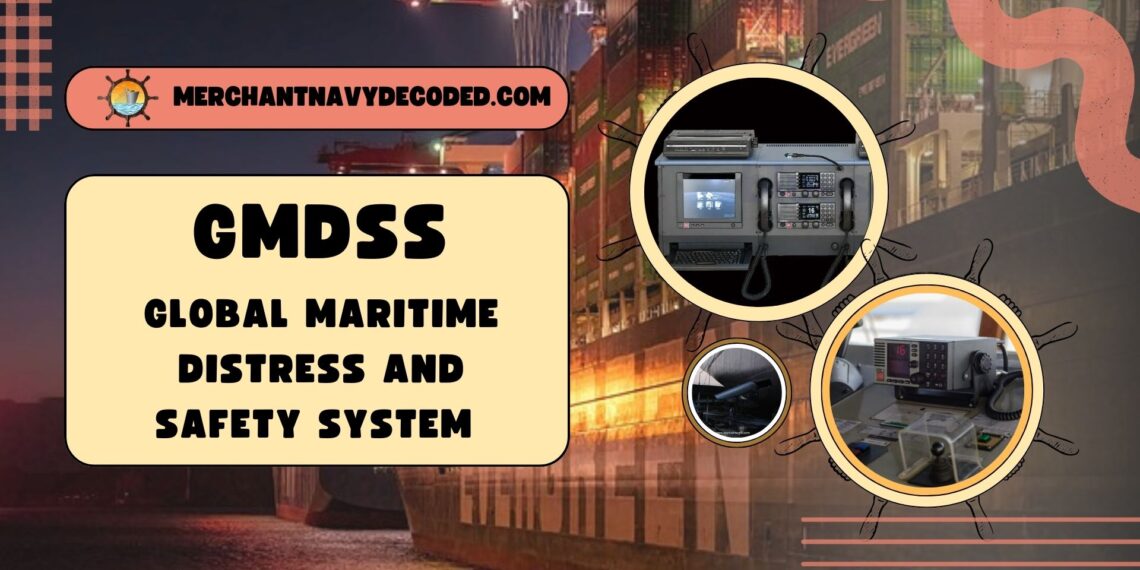What is Global Maritime Distress and Safety System (GMDSS)
1: Overview
The Global Maritime Distress and Safety System (GMDSS) is a modern communication system on ships that ensures ships are never alone in an emergency, providing reliable distress alerts and communication globally.
GMDSS is approved by the International Maritime Organization (IMO). It integrates with satellite communication, Very High-Frequency (30 MHz to 300 MHz), Medium-Frequency radios (300 KHz to 3MHz), High-Frequency radios (3 MHz to 30 MHz), and modern technology to enhance maritime safety. GMDSS supports search and rescue operations and ensures quick communication between ships and shore stations.
2: What is GMDSS?
| Aspect | Details |
| What is GMDSS? | A global safety system approved by the IMO to enhance communication for ships and protect the marine environment. |
| Goal | To ensure smooth communication during normal operations and emergencies. |
| Foundation | Established under the International Convention for the Safety of Life at Sea (SOLAS). |
| Key Features | Combines advanced technology with standardized procedures. |
| Who it apply to? | All ships, regardless of size or type. |
| Purpose of Communication | Enables effective contact with nearby ships, marine traffic centers, and shore-based rescue services. |
| Importance | Saves lives, prevents disasters, and minimizes damage to ships and the sea. |
| Sea Areas (A1, A2, A3, A4) | Defines regions to allocate the appropriate communication equipment for each area. |
GMDSS categorizes different Sea Areas to allocate the appropriate communication equipment for each specific region. These areas (A1, A2, A3, and A4) are categorized to ensure that ships have the necessary equipment for effective distress communication based on their location.
| Area | Range | Equipment |
| A1 | 20 to 50 NM | VHF DSC |
| A2 | 50 to 400 NM | VHF + MF |
| A3 | 70°N to 70°S | VHF + MF + One INMARSAT |
| A4 | Above 70°N or 70°S | HF + MF + VHF |
3:- Why is GMDSS Important?
GMDSS has transformed maritime safety by ensuring:
- Global Coverage: All of the world’s oceans, even isolated regions, are covered by extensive communication networks.
- Standardization: Ships and rescue coordination centers can communicate easily thanks to standard equipment and procedures.
- Enhanced Safety: The effect of an emergency can be reduced by timely sending alarm warnings and collaboration with rescue agencies.
- Regulatory Compliance: Vessels that comply with GMDSS regulations are guaranteed that they meet global safety standards.
4:- What are the Components of GMDSS?
GMDSS has many important components that ensure its performance and efficiency:
4.1: Ship radio stations
Ship radio stations, which are installed with equipment such as Very High Frequency, Medium Frequency, and High-Frequency radios that allow connectivity over a range of distances, are essential for communication in both emergencies and regular operations.
Frequencies of the specific band are:
- Medium Frequencies: 300 KHz to 3 MHz
- High Frequencies: 3 MHz to 30 MHz
- Very High Frequencies: 30 MHz to 300 MHz
4.2: INMARSAT
Long-distance communication is made possible through satellite communication systems called INMARSAT. INMARSAT is operated by the satellite and it includes ship earth station terminals INMARSAT B, C, and F77. It is used to transfer the data between ship to ship (STS), ship to shore (STS) and also priority telephone service is also provided in case of rescue
4.3: Digital Selective Calling
The automated technology called Digital Selective Calling (DSC) enables it to send regular messages and distress signals with extreme precision.
4.4: Emergency Position Indicating Radio Beacons (EPIRBs)
By sending signals to satellites, Emergency Position Indicating Radio Beacons (EPIRBs) are essential tools for detecting ships in danger. It is also called the secondary means of distress alerting.
4.5: SARTs (Search and rescue transponders)
SARTs or search and rescue transponders, boost rescue efforts by sending signals that assist in locating people or boats in difficulty.
4.6: NAVTEX
Navigational alerts and other current maritime safety information are provided because of NAVTEX Receivers. NAVTEX is used to transfer MSI maritime safety information which stores weather forecast warnings, navigational warnings, search and rescue notices, and other similar safety information.
5: What are Ship Radio Stations?
Ship radio stations are the foundation of communication in the sea. They are made up of radios with Digital Selective Calling (DSC) capabilities that operate at very high frequencies, medium frequencies, and high frequencies over the seas.
These variable frequency radios allow ships to communicate efficiently with rescue coordination centers and other nearby ships as well as to raise automatic distress alarms. Ship radio stations are essential for operations because they guarantee compliance with international standards.
6: Where are GMDSS Regulations Specified?
Chapter IV of the International Convention for the Safety of Life at Sea (SOLAS) has a detailed description of the rules regulating GMDSS. For vessels to follow GMDSS protocols, these rules specify the equipment requirements, operating procedures, and compliance criteria that must be met. Furthermore, regional guidelines are provided by national regulations, such as the U.S. Code of Federal Regulations (47 CFR Subpart W), to guarantee uniform application of GMDSS requirements around the globe.
7: What are GMDSS Regulations?
The following types of vessels are covered under GMDSS regulations:
Passenger Ships: To protect the safety of both passengers and crew, all passenger ships traveling internationally have to follow GMDSS regulations.
Cargo Ships: GMDSS requirements must be followed by ships traveling internationally that have a gross tonnage of 300 or more. These rules guarantee that ships involved in international trade have reliable emergency communication systems.
In addition to improving the security of the water, compliance with these rules guarantees that ships are sufficiently outfitted to manage communication difficulties in a variety of maritime environments.
8: How to Conduct a GMDSS Inspection
Verifying the operation and safety of a vessel’s communication systems requires a comprehensive GMDSS examination. Here is a detailed checklist that is followed to conduct the inspection:
- Check Equipment functionality to make sure that all radio communication equipment, such as HF, VHF, and MF radios, are in good operating order by testing them.
- Verify Documentation by verifying that operator certifications, radio licenses, and other required paperwork are now valid.
- Test Emergency Batteries with backup power sources can maintain communication systems in the event of a power outage.
- Examine SARTs and EPIRBs that devices are registered correctly and are in working order.
- Update materials with all maritime safety materials and operating instructions are current.
Perform routine drills to evaluate the crew’s and equipment’s preparedness by simulating emergencies.
9: Understanding Sea Areas under GMDSS
The world’s oceans are separated into four different zones under the GMDSS architecture and each has unique requirements for communication. These sections are intended to provide vessels operating in various locations thorough coverage.
| A1 | VHF radio with Digital Selective Calling (DSC) and Radiotelephone (RT). | Approximately 20-30 nautical miles from VHF coast stations. | Continuous DSC alerting ensures prompt responses to distress signals. |
| A2 | Medium Frequency (MF) radio with DSC and RT. | Up to 150 nautical miles from MF coast stations. | Excludes Sea Area A1 and provides coverage for regions beyond the range of VHF communication. |
| A3 | High Frequency (HF) radio and Inmarsat geostationary satellites. | Between 70°N and 70°S. | Provides global coverage, excluding polar regions, and ensures continuous alerting through satellite communication. |
| A4 | High Frequency (HF) radio with DSC. | Polar regions above 70°N and below 70°S. | Designed for vessels operating in remote and extreme environments, where satellite communication may not be feasible. |
10: Portable Marine Radio (Survival Craft Transceiver)
Portable marine radio also known as the survival craft transceiver, is an essential GMDSS component. A portable marine radio is kept on the bridge and can be used for communication aboard or in emergencies when personnel board survival crafts. In emergencies, it facilitates coordination between survival crafts and search-and-rescue units.
Key Requirements:
- Operable by unskilled personnel
- Transmits and receives on 156.8 MHz (Channel 16) and 156.3 MHz (Channel 6)
- Withstands a 1-meter drop
- Watertight to 1 meter for 5 minutes
- Minimum power: 0.25 watts
- Includes power reduction switch
- Omnidirectional, vertically polarized antenna
- Battery life: 8 hours (Nickel Cadmium or Lithium)
11: Frequently Asked Questions
- What is GMDSS?
- GMDSS is a communication system that ensures ships can send distress alerts and communicate globally in emergencies.
- Who needs to follow GMDSS rules?
- Passenger and cargo ships over 300 gross tons must comply with GMDSS regulations when traveling internationally.
- What are Sea Areas in GMDSS?
- GMDSS divides the ocean into four Sea Areas (A1, A2, A3, A4) with different communication equipment requirements.
- What is a Portable Marine Radio?
- Portable Marine Radio is a survival craft transceiver used in emergencies to communicate between survival crafts and rescue teams, with a battery life of 8 hours.
- How is GMDSS maintained?
- GMDSS inspections check if communication equipment is working, verify backup power, and ensure emergency devices like SARTs and EPIRBs are ready.
Disclaimer :- The opinions expressed in this article belong solely to the author and may not necessarily reflect those of Merchant Navy Decoded. We cannot guarantee the accuracy of the information provided and disclaim any responsibility for it. Data and visuals used are sourced from publicly available information and may not be authenticated by any regulatory body. Reviews and comments appearing on our blogs represent the opinions of individuals and do not necessarily reflect the views of Merchant Navy Decoded. We are not responsible for any loss or damage resulting from reliance on these reviews or comments.
Reproduction, copying, sharing, or use of the article or images in any form is strictly prohibited without prior permission from both the author and Merchant Navy Decoded.



